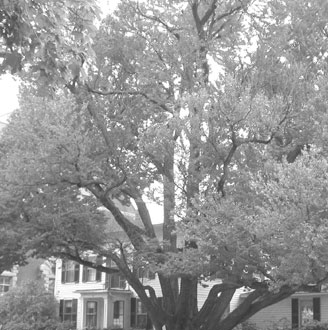|
|
Katsura Tree Preservation 11/02/03
The fate of the Katsura tree will be decided by the Church's Vestry. Please show your support to preserving the tree. Come to a vigil in front of Grace Church Monday November 3, 2003 at 6:30 p.m .while they decide its fate.
The
Katsura's current condition: The tree has large amount of decay in top of central leader with some large rotted areas in the lower region of the same leader. Likely this leader will have to come out. Extent to which the rot has extended to the base of any other trunk must be established. Several dead branches need pruning and the cables attached to the main leader will have to be reattached when the main leader is removed. The
cables are currently well attached and, according to Ed Cotton,
arborist: "… it is so securely cabled right now that even if it
breaks (and I don’t think it will break because its cabled up so
securely) it would hang up, and not hit the ground, not be
dangerous." General
Consensus:
Nearly all of the arborists contacted (9) said that the tree
could be "saved" (i.e. repaired/restored) and made entirely
safe for the public. Longevity:
Katsura trees don't attract many pests and are long lived. Several trees
planted in Amherst from seeds of this Katsura about 3 years later (by
Mass Agricultural School) are still alive and well. According to Tom
Houston, arborist in Shutesbury, the Katsura at Grace "…can live
at least 50 more years, with proper care. Pruning:
According to the arborists consulted, the tree would have to be pruned
(none said severely, to the point of disfigurement”) and re-cabled. Support
structure: Several
experts mentioned the need for a structural replacement for the rotted
central leader that would hold up the branches, which are now cabled to
the central leader. With tree foliage, the support would be
inconspicuous. Without foliage, the structure would be noticeable, but
need not be ugly. A design is being sought to determine appearance and
cost. Testing:
A strength-loss test of the areas with large cavities could be
performed to see which branches need to be removed, and if the tree has
sufficient strength to maintain itself.
A root flare excavation, using an air spade would expose certain
areas of the roots without damaging them and indicate where the support
column would be located so as not to damage the roots. Improving
the health of the tree:
The use of mycorrhizael inoculations would enhance the beneficial
relationship between the root and the mycorrhizael
fungi. Costs:
Minimal.
In order to keep the costs of the preservation effort down, a local
structural engineer could help with the design, steel distributors and
local welders in the community could contribute the steel and welding
service, and local arborists could contribute use of their cherry
pickers. Action:
Bill DeVos, internationally known tree surgeon from Vermont, offered to
donate his fee to design the support structure.
Ed Cotton from Northampton, offered free pruning of the tree for
its lifetime, and Tom Houston has identified volunteers for welding,
providing equipment, engineering, and masonry. If removal is decided: It is necessary to consider also the cost to cut the existing tree (+/-$3000), the cost to plant another Katsura (cost would depend on size planted), and, if another were to be planted in the same location, the cost to grind the stump.
|
|||
|
Next Step:
Support the
Katsura Contact: Grace Episcopal Church
grace@gracechurchamherst.org
|
||||
|
|
||||
